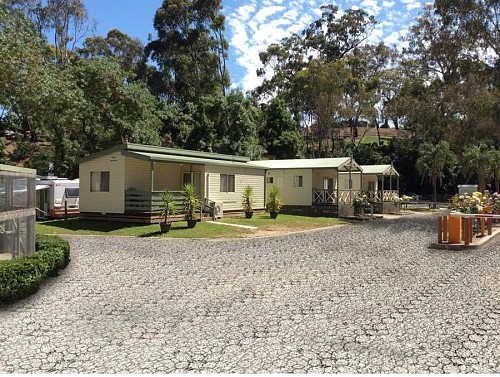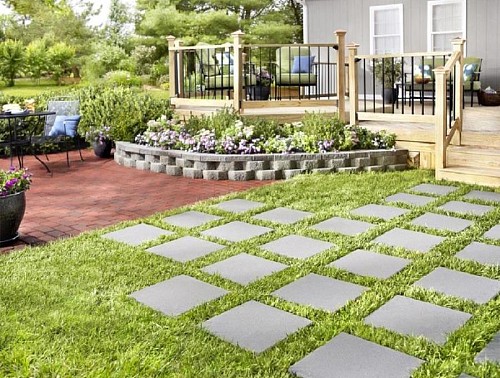Pervious Concrete Is An Eco-Friendly Paving Option
 Homeowners love concrete, for both interior and exterior use. Outdoors, large expanses of concrete can create environmental problems, though, as they block stormwater from draining off into the soil. The solution? Pervious concrete is a material that provides the strength and durability of standard concrete, yet permits rain and melted snow to drain easily and naturally.
Homeowners love concrete, for both interior and exterior use. Outdoors, large expanses of concrete can create environmental problems, though, as they block stormwater from draining off into the soil. The solution? Pervious concrete is a material that provides the strength and durability of standard concrete, yet permits rain and melted snow to drain easily and naturally.
We consulted Hunter McFarlane, construction expert at Lowe’s, for detailed information on the pros and cons of pervious concrete.
What is pervious concrete?
Pervious concrete (AKA permeable concrete) is a paving system for driveways, courtyards, pathways, parking lots, and more. It’s composed of aggregate particles coated thickly with an air-entrained paste of water and cement, containing very little sand (or none) to increase its permeability. These concrete systems are carefully designed with patterned structures, which allow rainwater and snowmelt to naturally and effectively sink back into the soil.
Permeable concrete is an environmentally friendly paving option for removing standing waters from large spaces of pavement. Its use is included in the EPA’s recommended Best Practices for dealing with storm water runoff.
Where is pervious concrete used in the yard?
Pervious concrete is most often used commercially, in large parking areas and paved lots. Residentially, permeable concrete can be used for driveways, pathways, and walkways. Permeable paving can also be applied to low traffic or unpaved roads.

What are the advantages of pervious concrete?
Permeable paving lessens the worry of puddles, holes, mud, and loose tiles. Cracks built into the design of the pavers prevent oil and puddles draining from driveways into street water systems. The natural collection of rainfall returns to the soil and recharges the groundwater, reducing pollution and soil erosion, not to mention damage to the concrete.
Drainage systems on real estate properties are becoming expensive, but permeable concrete reduces stormwater buildup, lessening the need for water retention ponds, swales, or similar installations.
Pervious concrete may be tinted in various attractive hues, and stamped or saw cut for interesting decorative concrete textures.
Sidewalks and paths made of pervious concrete are accessible to people using mobility aids, such as walkers or wheelchairs, in accordance with the Americans with Disabilities Act.
What are the disadvantages?
It’s necessary to hire a contractor experienced with permeable concrete for successful installation. Proper prep is vital, as the soil must be level and compact, and must have a gravel base initially installed. Then, the subgrade (mixture of gravel) used to create the permeable pavement has to be moistened frequently. The pavement needs to be cured up to seven days after installation to ensure it gains durability and doesn’t dry too quickly.
Permeable concrete is more expensive than other patio, hardscape, and garden path options. A package of 18 Gravalock Slim Grid 56, sold exclusively at Lowe’s, is $145.07 ($2.42/sq ft) while a standard, stone paved patio or pathway can range from $1.67 to $2.06/sq ft, depending on size and type.
The choice of sealants for pervious concrete is more limited than for other types of pavement. Seal with a product that allows vapor transmission, and apply only a light coat.
Pervious concrete tends to require regular sweeping and occasional pressure-washing to remove dust or plant growth that might otherwise clog the pavement.

Is pervious concrete the best material for a residential project?
Permeable concrete is often used on wide parking lots or spaces of pavement for draining large amounts of water off a large space quickly. For most residential hardscaping, permeable concrete isn’t essential, as the width of most patios, sidewalks, or pathways is small enough to allow drainage on the sides. A typical, comfortable sized 4-ft wide garden path will not block rainwater or call for additional drainage options.
For homeowners who’d like to build a DIY patio, walkway, or garden path, standard stone materials are inexpensive and easy to install without professional help. Drainage rock can be used in the bottom of patio containers to improve bottom drainage and to prevent soil leaking onto decks and patios.
Laura Firszt writes for networx.com.
Looking for a Pro? Call us (866) 441-6648

Average Costs
Related Experiences

Can You Trust Your Contractor? Here’s A Surefire Test

Yard Cleanup By A Local Landscaper Who Cares About Customers



